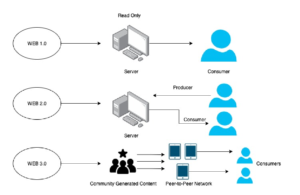The next generation of the web has arrived. Although, it may be early we can get a glimpse of how the web as we know if will transform in the coming years with crypto currencies, NFTs, smart contracts and the DeFi ecosystem. To understand the transformation of the web from the 90’s until now, let’s take a brief history at how the Web first came to be…
History of the Web
The first iteration of the Internet comes to us in the early to mid 90s. This is now known as “Web 1.0”. In this early iteration, web content was comprised of static HTML pages that were served over a TCP/IP connection. However, the content was not dynamic and could only be consumed by the end user, there was little to no interactivity. Fast-forward to the early 2000’s and we start to see web applications shift into a new paradigm. This shift is known as Web 2.0, and this paradigm is still the dominant one we are in today. This brought us dynamic websites, user interaction, curated feeds and social media, audio/video streaming. This provided a much more robust experience for the end user. However, with this shift, we saw many issues come up in respect to data privacy, a small handful of players centralizing web servers, and the end user having little control on how their data is being used.
Web 3.0 aims to solve this problem and bring the power back to the user, the way it should be. Moving away from centralized servers and systems to P2P (Peer-2-Peer) systems with no single points of failure and put you back in charge of your precious data.

True Decentralization
In our earlier blog posts, we talked smart contracts. In Web 3.0, instead of having all business logic on a traditional centralized web server, we leverage a decentralized blockchain network (Ethereum, Cardano, Polkadot etc.) and interact with the smart contract through a web interface. However, if we’re hosting our web front-end files that are communicating with the blockchain on a centralized server or hosting, we’re not truly decentralized.
This is where IPFS (Interplanetary File System) comes in. In a Web 2.0 environment, to access content, in this case, our web front end that interacts with our smart contracts, we enter a URL (Uniform Resource Locator) into our browser. We need to know the location of which server and IP this content lives. For example, Build Your Blocks is located at 153.92.7.21. A DNS (domain name server) will keep track of which domain name matches which address or IP.
Web 3.0 websites and apps don’t have a location, they can’t. The content is distributed over peer-to-peer networks, no central servers like we have in Web 2.0. So, instead of using a URL, The distributed content has a unique identifier, in the case of IPFS this identifier is known as the CID (Content ID). The verbiage may be different for other applications and may not be called CID’s but the idea is the same. For example, an IPFS address can look like this: https://gateway.pinata.cloud/ipfs/QmW7S5HRLkP4XtPNyT1vQSjP3eRdtZaVtF6FAPvUfduMjA. Everything after /ipfs is known as the CID, unique to the content. Since the blockchain is immutable, if the web master decides to change any content, the entire CID will change and the old address will not carry the new changes. There are ways around this such as exposing a public key hash instead of a CID that always routes to the most up to date content.
This Is Only The Beginning
There is much more to the story of decentralization. We are only beginning to scratch the surface and seeing the start of apps migrating from a web 2.0 to a web 3.0 paradigm. As we see today, Web 2.0 has had its issues with data privacy and as the web becomes more and more centralized by a small handful of tech players, the desire for web 3.0 becomes stronger.



Very rapidly this web site will be famous amid all blogging and site-building visitors, due
to it’s pleasant content
I wholeheartedly endorse every idea you’ve outlined in your post. They are undeniably persuasive and will undoubtedly be successful. However, the postings are rather brief for novice readers; could you kindly extend them slightly in the future? I appreciate the post.